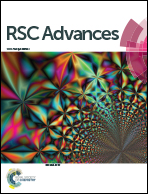Controlled synthesis of ZnxCd1−xS nanorods and their composite with RGO for high-performance visible-light photocatalysis†
Abstract
Monodisperse and ultrafine ZnxCd1−xS (ZCS) nanorods with hexagonal phases were controllably synthesized by a facile one-pot approach. The band gap of these alloyed nanocrystals can be tuned in a broad range from 2.41 to 3.78 eV by simply changing the molar ratio of the two precursors. All the ZCS samples exhibit a band gap-related and aspect ratio-dependent photoresponse to visible light. Zn0.5Cd0.5S nanorods with a suitable band gap and aspect ratio display the highest photoresponse, even 25 times higher than that of Zn0.875Cd0.125S. Graphene was chosen as a co-catalyst for 1D Zn0.5Cd0.5S nanorods due to its 2D structure and excellent conductivity. The Zn0.5Cd0.5S/RGO nanocomposites with a RGO content of 2.0 wt% showed the highest photocatalytic activity for the degradation of methylene blue (MB), which is mainly due to the uniform dispersion of ZCS nanorods on RGO and the enhanced separation rate of photoinduced electrons and holes by fast transfer of the photogenerated electrons through the contact line-to-line interface between ZCS nanorods and RGO nanosheets.


 Please wait while we load your content...
Please wait while we load your content...